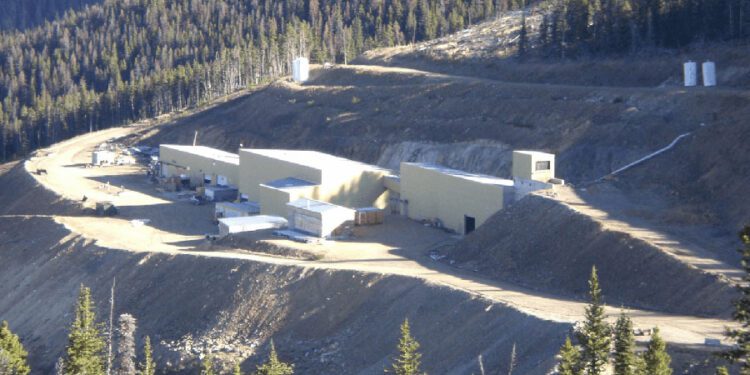Maiden Airborne Survey Highlights Potential For Larger Scale Gold Sytsem
Tempus Resources Ltd (ASX:TMR) (TSXV:TMRR) (OTCQB:TMRFF) has obtained promising results from the first ever high resolution airborne magnetic and radiometric geophysical surveys completed over the entire Elizabeth Gold Project in Southern BC, Canada.
The Elizabeth Gold Project is the flagship project for Tempus and is located in the Bralorne – Pioneer Gold District of southern British Columbia. The 115 sq. kmproject is characterised as a relatively under-explored high-grade mesothermal gold system that presents itself in relatively wide (typically ~1-5m wide) vein sets.
President and CEO, Jason Bahnsen, said the high-grade quartz veins encountered in the drilling at Elizabeth show close geological similarities to the Bralorne – Pioneer mesothermal vein system (approximately 30km away), which was mined to a depth of approximately 2,000 metres and produced more than 4 million ounces of gold over a period of 50 years.
“The results of the geophysical surveys show that the intrusive system that hosts the gold veins at Elizabeth is much larger and extends much deeper than previously thought,” Mr Bahnsen said.
“here are also two additional large-scale anomalies within the project licence. The results highlight the potential for Elizabeth to complement its high-grade nature with very large scale.”
In June 2021, Precision GeoSurveys Inc. was contracted to complete airborne magnetic and radiometric surveys over the Elizabeth Gold Project and completed 97 lines for a total of 735 line-kilometres. Flight lines are oriented east-west with north-south tie lines and spaced 200 metres across the entire 115 sq. km Elizabeth property. Over the Elizabeth Main and Elizabeth East Zones a line spacing of 100 metres was flown to increase the resolution and detail over these zones.
The airborne magnetic survey data was reviewed and interpreted by Insight Geophysics Inc. using 3D magnetization vector inversion (MVI) modelling.
The geophysical surveys identified the Blue Creek Porphyry, which is the known host of the high-grade Elizabeth gold-quartz veins, as a relative magnetic low anomaly within the Shulaps Ultramafic Complex. From this correlation of geology and geophysics it was determined that the Blue Creek Porphyry, originally explored and mapped to approximately 1.1 sq. km in size, is likely much larger. The airborne magnetic survey and MVI 3D modelling interpret the Blue Creek Porphyry to be at least four-times the size at approximately 4.5 sq. km.
This new geophysical data and interpretation of the Blue Creek Porphyry is also extensive at depth, revealing a robust intrusion extending to at least 2km deep (ie, approximately 10x deeper than mineralisation has currently drill-tested). Such an interpretation further indicates the analogous nature of Elizabeth’s potential relative to the nearby Bralorne gold deposit.
Historically, the boundaries of the Blue Creek Porphyry have been poorly defined based on mapping of sparse outcrops and therefore not well understood. The airborne surveys, the first of their kind at Elizabeth, are very encouraging as they define a transformationally larger footprint of the main porphyry which gives way to the necessary host geology along strike of the currently known Elizabeth vein/structures as well as unexplored areas to the north, south, and east.
In addition, two other magnetic low anomalies have been identified within the Elizabeth licence area as potential intrusive bodies similar to the Blue Creek Porphyry. These two anomalies show strong continuity along strike and are also extensive at depth.
The Blue Creek Porphyry, which hosts the Elizabeth gold-quartz veins, is thought to have intruded the Shulaps Ultramafic Complex during the late-Cretaceous (70.27 ± 5.25 Ma, by Ar-Ar) and belonging to the late stages of the Coast Plutonic Complex. This timing makes it close in proximity to the timing of Bralorne mineralisation (approximately 30km away) and being associated with the same, regional, transpressional environment. Bralorne is a well explored mesothermal vein system, which was mined to a depth of approximately 2,000 metres and produced more than 4 million ounces of gold over a period of 50 years.
The Shulaps Complex is bounded by two major dextral faults, the Yalakom Fault to the north on the Elizabeth property) and the Marshal Creek, Quartz Mountain Faults to the south and west. Within these two regional fault sets are sigmoidal faults, namely the Mission Ridge Fault and the Red Mountain Fault. It is these second order sigmoidal structures that are influential in the Elizabeth vein/fault systems and give them the southwest orientation.
For further information please visit: https://www.tempusresources.com.au












